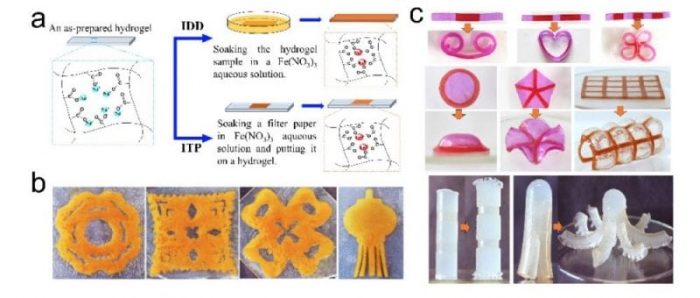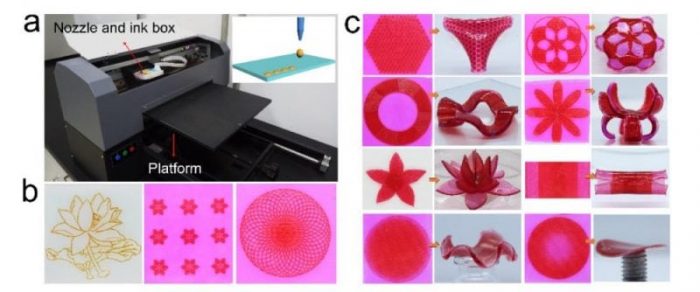
Imagine what functions can be performed with a soft, flexible but tough transformer that can change its shape upon external stimuli? Hydrogels are three-dimensionally cross-linked polymeric networks that can absorb a large amount of water while maintaining their solid-like shapes. They are typically soft and wet materials. Some smart hydrogels can change their geometric shapes to external stimuli, such as temperature, pH value, solvents, etc. Shape deformable hydrogels have wide potential applications in manufacturing soft machines, soft robotics, and artificial muscles.
Shape deformation of hydrogels is generally driven by the nonuniform internal stresses caused by the uneven swelling/ deswelling of the different parts of a gel sample. Therefore, macroscopic intrinsic structural inhomogeneity or asymmetry is a prerequisite for the deformation of the gels. Recently, professor Huiliang Wang and his Ph. D. candidate Miss Xin Peng from Beijing Normal University, China reported a series of works on the simple preparation of shape deformable hydrogels, precise programming of their shape deformations and their applications.
The first type of shape deformable hydrogels we reported are Janus hydrogels with different distributive components/cross-linking densities across the thickness prepared by using molds with different hydrophilicity/hydrophobicity. When the hydrogels are formed in the molds made of Teflon and glass plates, the extremely hydrophilic monomer sodium acrylate (NaAAc) mostly aggregates to the hydrophilic glass plate and forms a more hydrophilic phase, while a less hydrophilic phase is formed close to the hydrophobic Teflon side due to the aggregation of interpolymer complexes.
These Janus hydrogels undergo bending-unbending deformations upon swelling in water and deswelling in ethanol, due to the different swelling/deswelling rates of the two sides. Therefore, they can be used to prepare soft machines, such as a propeller and a manipulator (Figure 1a and b, Movies 1,2 ) (Adv. Funct. Mater. 2016, 26, 4491-4500).
Janus hydrogels are also prepared by using the polymer poly(N-isopropylacrylamide) (PNIPAM) and graphene oxide (GO) nanosheets as the main functional components. Hydrogels made from PNIPAM are thermo-sensitive since they have a sharp volume change about 33 °C. GO sheets absorb and transform near-infrared (NIR) irradiation into thermal energy. Therefore, the obtained hydrogels can undergo bending deformations upon heating by immersing in hot water or under NIR irradiation and unbending deformations upon swelling in cool water. The Janus PNIPAM/GO hydrogels are also used to prepare soft manipulators, which can be actuated by hot water or remote NIR irradiation (Figure 1c and d) (Chin. J. Polym. Sci. 2017, 35, 1268-1275).
The second type of shape deformable hydrogels are hydrogels with locally different swelling behaviors prepared by local introducing of metal cations into hydrogels containing a negatively charged polyelectrolyte. The complexation between metal cations and the negatively charged polyelectrolyte increases the cross-linking density and hence change the swelling/deswelling behaviors of the hydrogels. Inspired by fabric dip-dyeing and transfer-printing techniques, we developed ion-dip-dyeing (IDD) and ion-transfer-printing (ITP) methods to adjust the deformation rate and extent of the Janus hydrogels (Figure 2a).
Complex patterns can be printed on the hydrogels through ITP on the assistance of filter papers (Figure 2b). By proper ion-transfer-printing on 1D hydrogel strips, 2D hydrogel sheets, and 3D hydrogel blocks, the hydrogel samples can undergo interesting shape deformations from 1D to 2D, 2D to 3D and simple 3D to complex 3D shapes (Figure 2c) (Adv. Funct. Mater. 2016, 26, 4491-4500).

Figure 2.Ion-dip-dyeing and ion-transfer-printingtechniques. (a) Schematic illustration of the IDD and ITP. (b) Patterns printed by ITP. (c) Shape deformations from 1D to 2D, 2D to 3D and 3D to complex 3D (Reproduced from Ref. 1, with permission from [Wiley]).

Figure 3. Ion-inkjet-printingtechnique.(a) A flatbed inkjet printer and schematic illustration of the IIP. (b) Patterns printed by IIP. (c) Shape deformations from 2D to 3D (Reproduced from Ref. 3, with permission from [Wiley]).
By programming the local irradiation on different parts of 2D hydrogel sheets, the hydrogel samples can undergo complex shape deformations from 2D to 3D (Movie 4) (J. Mater. Chem. B 2017, 5, 7997-8003).
The study, Mechanically strong Janus poly(N-isopropylacrylamide)/graphene oxide hydrogels as thermo-responsive soft robots was recently published in the Chinese Journal of Polymer Science.
Reference
- Peng, X.; Li, Y.; Zhang, Q.; Shang, C.; Bai, Q.-W.; Wang, H. Tough Hydrogels with Programmable and Complex Shape Deformations by Ion Dip-Dyeing and Transfer Printing. Funct. Mater.2016, 26, 4491-4500.
- Peng, X.; Liu, T.; Shang, C.; Jiao, C.; Wang, H. Mechanically Strong Janus Poly(N-isopropylacrylamide)/Graphene Oxide Hydrogels as Thermo-Responsive Soft Robots. J. Polym. Sci.2017, 35, 1268-1275.
- Peng, X.; Liu, T.; Zhang, Q.; Shang, C.; Bai, Q.-W.; Wang, H. Surface Patterning of Hydrogels for Programmable and Complex Shape Deformations by Ion-Inkjet-Printing. Funct. Mater.2017, 27, 1701962.








